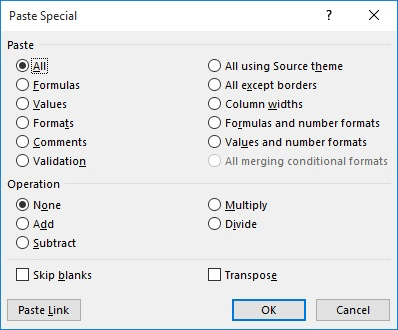Please Note: This article is written for users of the following Microsoft Excel versions: 2007, 2010, 2013, 2016, 2019, 2021, and Excel in Microsoft 365. If you are using an earlier version (Excel 2003 or earlier), this tip may not work for you. For a version of this tip written specifically for earlier versions of Excel, click here: Replacing Links with Values.
Written by Allen Wyatt (last updated April 20, 2024)
This tip applies to Excel 2007, 2010, 2013, 2016, 2019, 2021, and Excel in Microsoft 365
John has a large number of workbooks that have links in them and they are getting very large. He wonders if there is any way for Excel to convert the links to the data grabbed from those links so he can archive the old workbooks.
One thing to try is to open the workbooks that contain the links and then use Excel's tools to break the links. Make sure you keep a backup of your workbook (in case you mess things up) and follow these steps:

Figure 1. The Edit Links dialog box.
The result is that all the links are done away with, but the values last retrieved through the links remain in the workbook.
Another approach is to use Paste Special to "overwrite" your links. (This works well if you have a limited number of links in a worksheet.) Follow these steps:

Figure 2. The Paste Special dialog box.
If you have quite a few links in your workbook, then you will want to use a macro to do the link breaking. The following is an example of a simple macro to do the breaking:
Sub BreakLinks()
Dim aLinksArray As Variant
aLinksArray = ActiveWorkbook.LinkSources(Type:=xlLinkTypeExcelLinks)
Do Until IsEmpty(aLinksArray)
ActiveWorkbook.BreakLink Name:=aLinksArray(1), _
Type:=xlLinkTypeExcelLinks
aLinksArray = _
ActiveWorkbook.LinkSources(Type:=xlLinkTypeExcelLinks)
Loop
End Sub
It is important to remember, though, that links can be tricky. Links to other workbooks can be in formulas, names, charts, text boxes, and other objects, both visible and hidden, and in different combinations within formulas and those objects. Getting all the links and breaking them depends on the complexity of your workbook. If you have a complex workbook, then you may benefit by using the FindLink add-in created by Excel MVP Bill Manville. You can find it here:
https://www.manville.org.uk/software/findlink.htm
Note:
ExcelTips is your source for cost-effective Microsoft Excel training. This tip (7566) applies to Microsoft Excel 2007, 2010, 2013, 2016, 2019, 2021, and Excel in Microsoft 365. You can find a version of this tip for the older menu interface of Excel here: Replacing Links with Values.

Excel Smarts for Beginners! Featuring the friendly and trusted For Dummies style, this popular guide shows beginners how to get up and running with Excel while also helping more experienced users get comfortable with the newest features. Check out Excel 2019 For Dummies today!
Copying information from one place to another in a worksheet is easy. Copying hyperlinks may not seem that easy, but you ...
Discover MoreCombining workbooks that have cross-links to each other can offer some special challenges. This tip examines how you can ...
Discover MoreWhen you copy workbooks that contain links, you may be at a loss as to how to update those links. There are a couple of ...
Discover MoreFREE SERVICE: Get tips like this every week in ExcelTips, a free productivity newsletter. Enter your address and click "Subscribe."
2024-04-20 11:04:06
J. Woolley
The following dynamic array function in My Excel Toolbox lists external links:
=ListExLinks([SkipReference], [SkipHeader])
The result is similar to the Edit Links dialog minus its Update column (see Figure 1 above), but ListExLinks adds a Reference column to identify cells that contain a formula referencing the link. (If optional SkipReference is TRUE, the Reference column will be excluded.)
When using pre-2021 versions of Excel without support for dynamic arrays, review the PDF file UseSpillArray.pdf.
My Excel Toolbox also includes the LinksToMe macro to identify all workbooks with an external data link referencing the active workbook.
See https://sites.google.com/view/MyExcelToolbox
Got a version of Excel that uses the ribbon interface (Excel 2007 or later)? This site is for you! If you use an earlier version of Excel, visit our ExcelTips site focusing on the menu interface.
FREE SERVICE: Get tips like this every week in ExcelTips, a free productivity newsletter. Enter your address and click "Subscribe."
Copyright © 2026 Sharon Parq Associates, Inc.
Comments